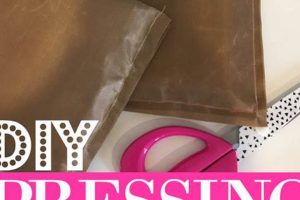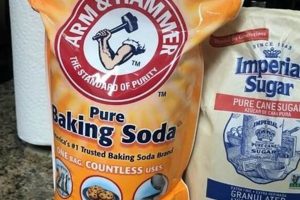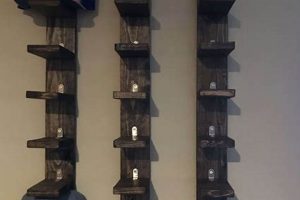The creation of stencils for applying ink to a substrate, typically fabric or paper, through a mesh stretched tightly over a frame is a fundamental aspect of serigraphy. These stencils, when produced by individuals using readily available materials and methods outside of professional or commercial settings, exemplify a hands-on approach to printmaking. An example would be constructing a wooden frame, securing a mesh fabric to it, and then creating a stencil using photo emulsion or paper cutouts to block areas of the mesh.
This method of stencil fabrication offers several advantages, including cost-effectiveness and accessibility. It allows individuals to explore printmaking without significant financial investment, fostering creativity and skill development. Historically, alternative methods of crafting these stencils have been essential for artists and hobbyists, particularly in situations where specialized equipment is unavailable or unaffordable. This approach empowers individuals to control the entire printmaking process, from design conception to final product.
The subsequent sections will delve into specific techniques for constructing these stencils, examining various mesh types, frame construction methods, and stencil creation processes. Detailed instructions and considerations for achieving optimal results will be provided.
Essential Considerations for Serigraphic Stencil Fabrication
The following points outline crucial considerations for those undertaking the construction of stencils for serigraphy independently. These suggestions aim to enhance the quality and durability of the fabricated stencils, leading to improved print results.
Tip 1: Mesh Selection: The selection of appropriate mesh fabric is paramount. Consider the thread count and material. Higher thread counts are suitable for intricate designs, while lower counts are better for bold, less detailed imagery. Polyester mesh offers greater durability and resistance to chemicals compared to nylon.
Tip 2: Frame Construction: Ensure the frame is rigid and square. Warped or uneven frames will compromise tension and affect print quality. Wood frames require sealant to prevent moisture absorption and warping. Aluminum frames offer superior stability and longevity.
Tip 3: Mesh Tensioning: Maintaining proper mesh tension is critical. Insufficient tension results in blurry prints. Over-tensioning can lead to mesh tears or frame distortion. Tension meters can provide accurate measurements, although manual stretching techniques can be employed with careful attention.
Tip 4: Stencil Coating: Apply photo emulsion evenly in a dust-free environment. Uneven coating leads to inconsistent exposure. Allow sufficient drying time, following the emulsion manufacturers recommendations. Control temperature and humidity during the drying process.
Tip 5: Exposure Time: Precise exposure time is essential for stencil resolution. Under-exposure results in a soft, weak stencil. Over-exposure can cause the stencil to become brittle and difficult to wash out. Conduct test exposures to determine the optimal duration for the specific emulsion and light source.
Tip 6: Washout Technique: Gently wash out the unexposed emulsion with a pressure washer or a suitable spray nozzle. Avoid excessive pressure, which can damage the stencil. Ensure all unexposed emulsion is removed, leaving clean, crisp lines.
Tip 7: Stencil Hardening: After washout, allow the stencil to dry completely. Post-exposure to sunlight or a UV light source can further harden the emulsion, increasing its durability for repeated prints. Follow the emulsion manufacturer’s recommendations.
Effective implementation of these practices will contribute to the production of high-quality, durable stencils for serigraphic applications, minimizing common issues and maximizing print consistency.
The following sections will provide detailed instructions and supplementary resources for implementing these techniques successfully.
1. Frame Rigidity
In the context of constructing serigraphic stencils independently, frame rigidity represents a critical factor influencing the quality and longevity of the stencil. The frame serves as the foundational structure upon which the mesh is stretched and secured. Any deformation or lack of stability in the frame directly affects the mesh tension and the consistency of the printing surface. For instance, a warped wooden frame will prevent uniform mesh tension, leading to uneven ink distribution and blurry prints. Similarly, a flimsy frame constructed from unsuitable materials can distort under the pressure of the squeegee, resulting in registration issues and compromised image fidelity.
The impact of inadequate frame rigidity extends beyond the initial printing process. Repeated use of a non-rigid frame can exacerbate existing structural weaknesses, leading to premature stencil failure. The constant stress placed on the frame during printing cycles can cause further warping or even breakage, rendering the stencil unusable. Materials such as aluminum or well-sealed hardwood are often selected for their superior rigidity and resistance to deformation, ensuring consistent performance over extended periods. The choice of frame material and construction method therefore represents a significant investment in the overall quality and durability of the resulting serigraphic stencils.
Ultimately, achieving and maintaining adequate frame rigidity is essential for successful independent serigraphic stencil fabrication. It addresses challenges related to print quality, registration accuracy, and stencil longevity. Understanding this connection allows individuals to make informed decisions regarding materials and construction techniques, enhancing the overall efficiency and effectiveness of the printmaking process. The proper construction and selection of the frame enables the creation of high-quality prints and reduces the expense of replacing stencils frequently.
2. Mesh Tension
Mesh tension, a critical parameter in serigraphic stencil fabrication, directly influences the quality and accuracy of the final print. Proper tension ensures consistent ink transfer and precise image reproduction. The ability to effectively manage and control mesh tension is therefore paramount for individuals creating stencils independently.
- Impact on Image Sharpness
Insufficient mesh tension results in a soft or blurry printed image. When the mesh lacks adequate tension, it deflects excessively during the squeegee stroke, causing the stencil to lose contact with the substrate and producing indistinct edges. Conversely, proper tension maintains a consistent and controlled contact, resulting in sharp and well-defined image details. An example of this effect is readily observed when comparing prints made with a slack mesh versus a taut mesh, with the latter exhibiting s
ignificantly superior clarity. - Effect on Ink Deposit Control
Mesh tension significantly affects the volume of ink deposited onto the substrate. Low tension allows for excessive ink flow, leading to thick, uneven prints. Conversely, high tension promotes a more controlled ink release, resulting in thinner and more consistent ink layers. This is particularly important when printing fine lines or halftones, where precise ink deposit is essential for accurate reproduction. Adjusting mesh tension offers a means of fine-tuning ink coverage to achieve desired print characteristics.
- Influence on Registration Accuracy
In multi-color printing, accurate registration is crucial. Improper mesh tension can lead to distortion of the printed image, making it difficult to align subsequent colors accurately. A mesh with uneven tension will stretch inconsistently during printing, causing misregistration and blurred results. Maintaining consistent and uniform tension across the entire mesh surface minimizes distortion and ensures precise color alignment. Examples of registration issues due to poor tension are often seen in amateur prints, where overlapping colors exhibit noticeable gaps or misalignment.
- Relationship with Stencil Durability
Excessive or uneven mesh tension can compromise the durability of the stencil. Over-tensioning can stretch the mesh beyond its elastic limit, leading to premature wear or even tearing. Similarly, uneven tension can create stress points within the mesh, accelerating its degradation. Proper tensioning techniques, coupled with appropriate mesh selection, contribute to a longer stencil lifespan and reduce the need for frequent replacements. This directly impacts the cost-effectiveness and efficiency of independent serigraphic stencil fabrication.
The ability to effectively manage mesh tension directly influences the quality, accuracy, and durability of stencils created for serigraphy. Therefore, techniques for achieving and maintaining optimal mesh tension are essential skills for anyone undertaking stencil fabrication independently, as these skills directly address the quality and longevity of their materials and final prints.
3. Emulsion Coating
Emulsion coating is a critical step in the creation of stencils for serigraphy, particularly within a context involving independent fabrication. The process directly influences the resolution, durability, and overall quality of the stencil, and by extension, the final printed image. The emulsion, a light-sensitive liquid, is applied to the mesh surface of the screen. Its purpose is to create a negative space that allows the ink to pass through to the substrate. Uneven application or improper drying of the emulsion can lead to inconsistent stencil thickness, resulting in prints with uneven ink distribution or blurred edges. For example, pinholes in the emulsion layer, caused by dust particles or insufficient coating, will permit unwanted ink flow, creating imperfections in the print.
The type of emulsion selected, its application method, and the environmental conditions during drying significantly affect the stencil’s performance. Diazo, photopolymer, and dual-cure emulsions each possess distinct characteristics in terms of sensitivity, exposure time, and resistance to solvents. A thicker emulsion coating generally creates a more robust stencil, capable of withstanding repeated printing cycles. However, excessively thick coatings can compromise fine detail reproduction. Proper application techniques, such as using a coating trough at the correct angle and speed, are crucial for achieving a uniform layer. Controlling temperature and humidity during the drying phase minimizes the risk of imperfections and ensures optimal adhesion of the emulsion to the mesh. Incorrect drying can lead to pinholes or an incomplete stencil that will not reproduce the intended pattern.
Effective emulsion coating is a foundational element in the independent fabrication of serigraphic stencils. It necessitates a careful selection of materials, meticulous application techniques, and control over environmental variables. The resulting stencil quality directly determines the achievable print resolution and the overall consistency of the final product. Mastering emulsion coating is critical for individuals seeking to achieve professional-quality results in their serigraphic endeavors. The connection between the steps is cause-and-effect. Therefore, in creating these stencils independently, the importance of mastering the emulsion coating process is paramount. The process will either yield success or failure in the final print product.
4. Exposure Control
Exposure control, in the context of independently fabricated serigraphic stencils, represents a pivotal element influencing the stencils fidelity and durability. The process entails selectively hardening the emulsion layer through controlled exposure to a light source, creating the image-bearing areas of the stencil. Deviations from optimal exposure parameters compromise the stencils ability to accurately reproduce the intended design.
- Exposure Time Optimization
Exposure time is directly proportional to the intensity of the light source and the sensitivity of the emulsion. Under-exposure results in a soft stencil, prone to breakdown during printing, as unhardened emulsion washes away prematurely. Over-exposure, conversely, renders the stencil brittle, impeding washout and potentially damaging fine details. Determining the precise exposure time, often through test strips, is essential for achieving a durable stencil that accurately represents the design.
- Light Source Consistency
The characteristics of the light source, including its spectral output and intensity, significantly impact exposure. Inconsistent light sources, such as fluctuating fluorescent bulbs, lead to unpredictable exposure results. Dedicated exposure units, employing consistent UV light sources, provide greater control and repeatability. The type of light source impacts the emulsion’s reaction; therefore, the selection and consistent use of a specific light source are integral to exposure control.
- Stencil Distance and Angle
The distance between the light source and the stencil influences the uniformity of exposure. Variations in distance across the stencil surface result in differential hardening of the emulsion. Maintaining a consistent distance and perpendicular angle between the light source and the stencil is critical for uniform exposure. Inadequate attention to these factors results in uneven stencil formation, impacting print quality.
- Transparency Quality
The transparency used to block light during exposure dictates the fidelity of the image transferred to the stencil. Low-quality or opaque transparencies block insufficient light, leading to under-exposure in unwanted areas. High-quality transparencies, with high optical density in the opaque regions, ensure sharp and well-defined image areas on the stencil. The quality of the transparency is a foundational element in achieving precise exposure control.
Mastery of exposure control is paramount in achieving professional-quality results in independently fabricated serigraphic stencils. The interplay between exposure time, light source consistency, stencil positioning, and transparency quality deter
mines the stencil’s ability to accurately reproduce the intended design and withstand the rigors of the printing process. Precise management of these factors minimizes stencil failures and optimizes print quality in independently executed serigraphic projects.
5. Washout Precision
Washout precision is a critical determinant of the success of independently fabricated serigraphic stencils. This process, involving the removal of unexposed emulsion, directly influences the clarity, accuracy, and functionality of the final stencil, consequently affecting print quality.
- Water Pressure Regulation
Excessive water pressure during washout can damage the delicate stencil, particularly in areas with fine lines or intricate details. Conversely, insufficient pressure may fail to adequately remove all unexposed emulsion, resulting in clogged mesh and compromised image resolution. The appropriate water pressure, typically achieved through adjustable spray nozzles or pressure regulators, must be carefully calibrated to achieve a balance between thorough cleaning and stencil preservation. In practical terms, observation of emulsion behavior under varying pressures, and adjustment accordingly, is essential in the context of independently created screens.
- Spray Nozzle Selection and Technique
The type of spray nozzle used and the technique employed significantly impact the washout process. Fan nozzles, which distribute water over a wider area, are generally preferred for initial rinsing, while pinpoint nozzles can be used for targeted removal of stubborn emulsion residue. Maintaining a consistent distance and angle between the nozzle and the stencil surface ensures uniform washout and prevents localized damage. Novices may encounter difficulties in this phase if spray technique is not refined via iterative practice.
- Water Temperature Control
Water temperature can affect the efficiency of emulsion removal. Warm water generally softens the unexposed emulsion, facilitating its removal. However, excessively hot water can damage the stencil or compromise its adhesion to the mesh. Similarly, cold water may prove ineffective in removing the emulsion, requiring prolonged washout times and increased pressure. Water temperature must be carefully monitored, especially when utilizing certain emulsion types with specific temperature sensitivities. Independent fabricators must be mindful of manufacturers recommendations.
- Visual Inspection and Iterative Washout
Visual inspection during and after the washout process is critical for identifying areas where unexposed emulsion remains or where the stencil has been damaged. Backlighting the stencil allows for a clearer view of any imperfections. Iterative washout, involving multiple cycles of spraying and inspection, ensures thorough removal of all unwanted emulsion while minimizing the risk of damage. This demands diligence and thoroughness on the part of the individual crafting the screen.
These interconnected facets collectively define the precision required during the washout phase of independent serigraphic stencil fabrication. Failure to address any one of these aspects can result in compromised stencil quality and subsequent printing issues. This process is particularly sensitive, as any errors can easily ruin the intended print screen. Therefore, careful attention to each is critical for optimal results. Mastering these techniques requires commitment and meticulous control over the variables involved.
6. Durability
Durability, concerning independently produced serigraphic stencils, is a critical attribute that directly impacts the longevity and cost-effectiveness of the printmaking process. A stencil’s ability to withstand repeated use and resist degradation from various factors determines its suitability for projects involving multiple prints or extended production runs. The materials and techniques employed during stencil fabrication directly influence its overall durability, affecting its performance over time.
- Mesh Material Resistance
The type of mesh fabric used in the stencil construction significantly contributes to its durability. Polyester mesh, for example, exhibits greater resistance to chemical solvents and abrasion compared to nylon mesh. This resistance translates to a longer stencil lifespan, particularly when using aggressive cleaning agents or printing with solvent-based inks. Choosing a more robust mesh material provides enhanced protection against degradation, extending the useful life of the independently fabricated stencil. Proper care and storage will result in stencils that can withstand frequent usage.
- Emulsion Hardness and Adhesion
The hardness and adhesion of the emulsion layer are pivotal in determining the stencil’s resistance to mechanical stress during printing. A properly exposed and cured emulsion forms a durable barrier that withstands the pressure of the squeegee and the abrasive nature of certain inks. Insufficiently hardened or poorly adhered emulsion is susceptible to chipping, cracking, or premature breakdown, significantly reducing the stencil’s lifespan. Selection of high-quality emulsions, coupled with proper exposure and curing techniques, contributes to enhanced stencil durability, thus maintaining the integrity of the image.
- Frame Stability and Construction
The stability and structural integrity of the frame play a critical role in maintaining mesh tension and preventing distortion during printing. A warped or unstable frame can compromise mesh tension, leading to uneven ink deposition and premature stencil failure. Sturdy frames, constructed from materials like aluminum or well-sealed hardwood, provide a stable foundation that minimizes stress on the mesh and emulsion, thereby enhancing the overall durability of the stencil. Maintaining the rigidity of the frame is thus an essential consideration in independent stencil fabrication. This can be achieved through proper material selection and construction techniques.
- Cleaning and Storage Practices
Proper cleaning and storage practices significantly extend the lifespan of independently fabricated stencils. Thoroughly removing all ink residue after each printing session prevents the buildup of hardened ink, which can damage the mesh and emulsion. Gentle cleaning agents, specifically formulated for screen printing, minimize the risk of chemical damage. Storing stencils in a clean, dry environment, away from direct sunlight and extreme temperatures, prevents warping and premature degradation. Diligent adherence to these practices contributes to prolonged stencil durability, translating to reduced replacement costs and increased efficiency in the printmaking process.
The various interconnected aspects of stencil construction, material selection, and operational procedures are crucial for establishing durability. A stencil’s longevity directly influences its economic value within the context of independent serigraphic endeavors. Prioritizing durability throughout the stencil fabrication process ensures a more sustainable and cost-effective approach to printmaking, reducing the need for frequent stencil replacements. The long-term efficacy of independent stencil production depends on careful consideration of the factors mentioned above.
Frequently Asked Questions
The following questions address common concerns and misconceptions regarding the independent creation of stencils for serigraphy. The information provided aims to clarify key aspects of the process and promote informed decision-making.
Question 1: What is the minimum investment required to construct stencils for serigraphy independently?
The minimum investment varies depending on the chosen materials and techniques. Basic methods, utilizing readily available materials, can be implemented with a relatively low initial outlay. However, achieving professional-quality results may necessitate investment in specialized equipment, such as exposure units and tension meters, increasing the overall cost.
Question 2: What mesh count is most suitable for general-purpose stencils?
A mesh count ranging from 110 to 160 threads per inch is generally suitable for general-purpose applications. Lower mesh counts are appropriate for bold designs with minimal detail, while higher mesh counts are better suited for intricate images requiring finer resolution. Experimentation may be necessary to determine the optimal mesh count for specific projects.
Question 3: What are the primary advantages of aluminum frames compared to wooden frames?
Aluminum frames offer superior stability, resistance to warping, and ease of cleaning compared to wooden frames. Aluminum frames also maintain consistent tension over extended periods, reducing the need for frequent re-stretching. However, aluminum frames typically incur a higher initial cost.
Question 4: What are the common causes of stencil failure during printing?
Common causes of stencil failure include insufficient mesh tension, improper emulsion exposure, inadequate washout, and chemical incompatibility between the ink and emulsion. Addressing these factors through meticulous technique and material selection minimizes the risk of stencil failure.
Question 5: Is it possible to reclaim and reuse stencils for multiple print runs?
Yes, stencils can be reclaimed and reused by removing the emulsion layer after each print run. Specialized stencil removers are available for this purpose. However, repeated reclamation can weaken the mesh and reduce its lifespan. Proper cleaning and handling are essential for maximizing stencil reusability.
Question 6: What safety precautions should be observed when working with photo emulsions and cleaning chemicals?
Photo emulsions and cleaning chemicals may contain hazardous substances. It is essential to wear appropriate personal protective equipment, including gloves, eye protection, and respiratory protection, when handling these materials. Work in a well-ventilated area and follow the manufacturer’s safety guidelines to minimize exposure risks.
These answers provide a foundational understanding of key considerations for independently fabricating serigraphic stencils. Further research and experimentation are encouraged to refine individual techniques and achieve optimal results.
The next section will present a detailed guide outlining a step-by-step process for constructing a basic serigraphic stencil independently.
Conclusion
The preceding sections have explored the multifaceted aspects of diy screen printing screens, emphasizing the significance of frame rigidity, mesh tension, emulsion coating, exposure control, washout precision, and overall durability. Effective management of these factors is paramount for achieving professional-quality results in independent serigraphic endeavors. Comprehension of the underlying principles and diligent application of recommended techniques minimize common challenges and maximize the potential for successful printmaking.
The independent fabrication of stencils for serigraphy represents a valuable skill for artists and hobbyists seeking greater control over the printmaking process. Continued exploration and refinement of these techniques will undoubtedly lead to further advancements in the accessibility and quality of serigraphic art. A commitment to precision and a dedication to ongoing learning are essential for unlocking the full potential of this versatile printmaking method.







